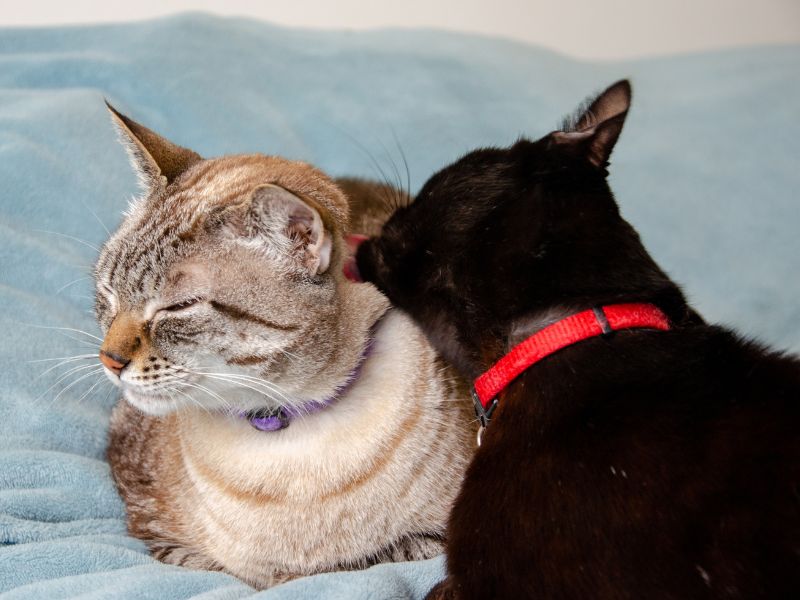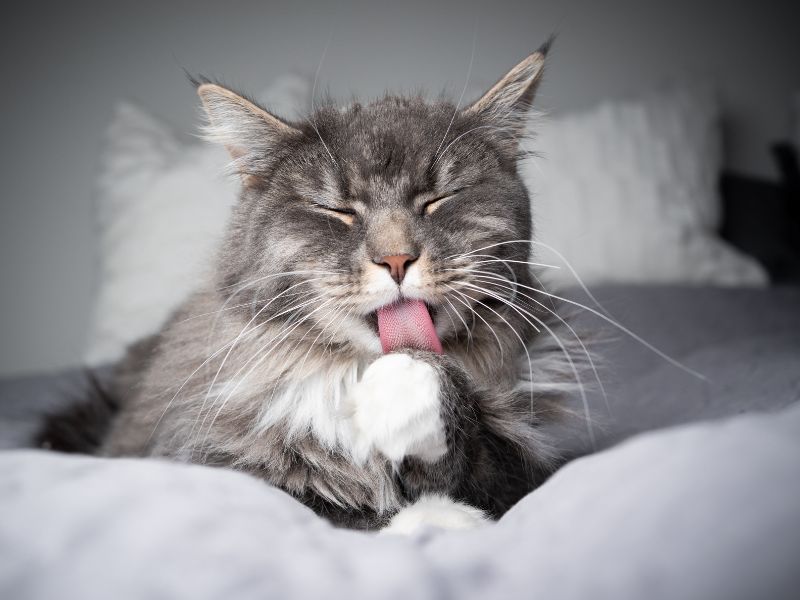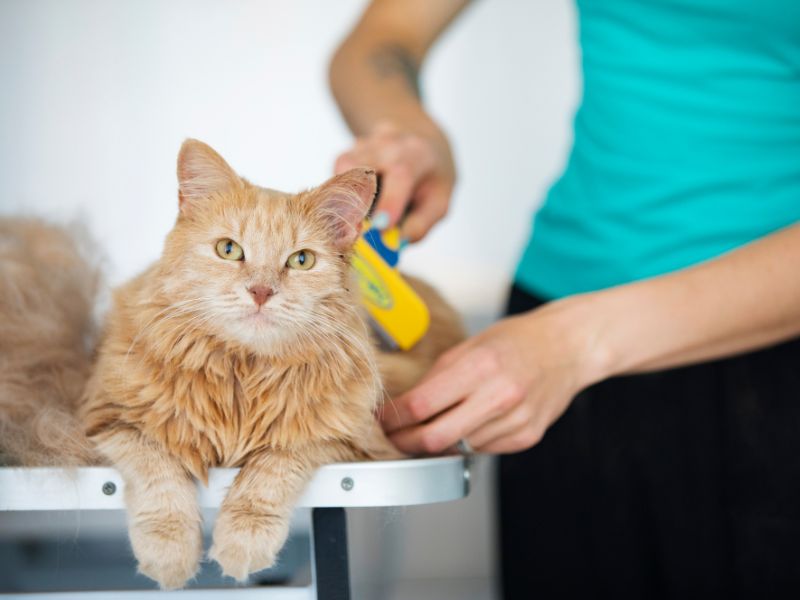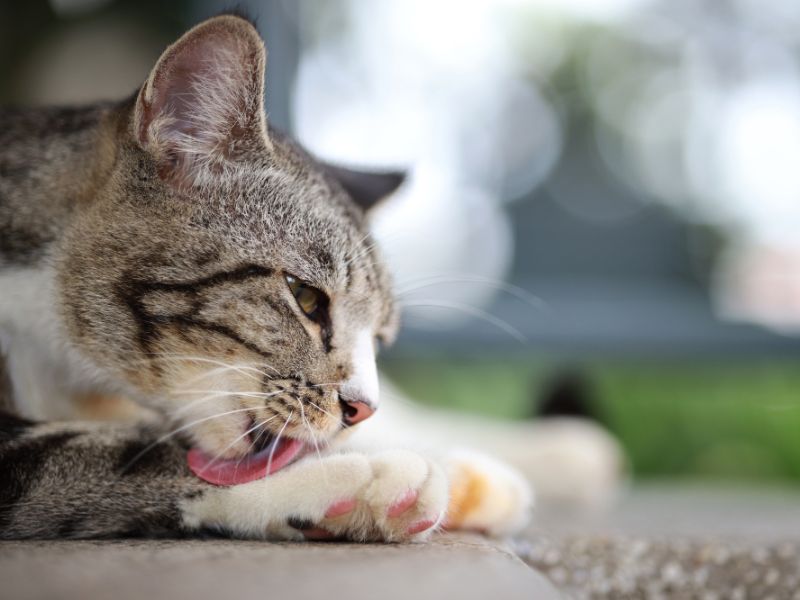Is your furry feline spending an excessive amount of time grooming itself? While it’s natural for cats to groom, there are times when this behavior can become excessive and raise concerns. Understanding the reasons behind your cat’s excessive grooming is essential to ensure their well-being. In this article, we will delve into the various factors that may contribute to your cat’s over-grooming tendencies. From stress and anxiety to skin allergies and parasites, there are a multitude of reasons why your cat may be spending an unusual amount of time licking and grooming itself. We will explore the symptoms to look out for, potential health issues that may be causing this behavior, and provide practical tips to help alleviate your cat’s excessive grooming habits. So, if you’re wondering why your cat is spending more time on self-care than usual, keep reading to discover the possible reasons behind this behavior and how to address it effectively.
Common Causes of Excessive Cat Grooming
Excessive grooming in cats can stem from various factors. One common cause is skin allergies. Cats can develop allergies to certain foods, environmental allergens, or even flea bites. When they experience itchiness or discomfort, they may resort to excessive grooming as a way to alleviate the irritation. Additionally, parasitic infestations, such as fleas or mites, can cause intense itching and lead to excessive grooming.
Another possible cause of excessive grooming is stress and anxiety. Cats are sensitive creatures, and changes in their environment or routine can cause them to feel anxious. This anxiety can manifest in excessive grooming as a form of self-comfort. Similarly, boredom or lack of mental stimulation can cause cats to engage in excessive grooming as a way to occupy themselves.
Lastly, pain or discomfort can also be a contributing factor to excessive grooming. Cats may groom excessively in an attempt to soothe sore muscles or joints. Dental issues, urinary tract infections, or other underlying medical conditions can also lead to excessive grooming.
It’s important to note that while grooming is a natural behavior for cats, excessive grooming can be a sign of an underlying issue. Observing your cat’s grooming habits and identifying any changes or patterns can help determine the cause and address it appropriately.
Medical Conditions That Can Cause Excessive Cat Grooming
Excessive grooming in cats can be a symptom of various medical conditions. One of the most common medical reasons for excessive grooming is dermatitis. Dermatitis refers to inflammation of the skin, which can be caused by allergies, infections, or even autoimmune diseases. When cats have dermatitis, they may groom excessively to relieve the discomfort and itching associated with the condition.
Another medical condition that can lead to excessive grooming is hyperthyroidism. Hyperthyroidism occurs when the thyroid gland produces an excessive amount of thyroid hormone. Cats with hyperthyroidism may groom excessively due to increased energy levels and restlessness caused by the condition.
Urinary tract infections can also cause cats to engage in excessive grooming. Cats with urinary tract infections may experience discomfort or pain while urinating, leading to excessive grooming as a way to alleviate the discomfort.
If you notice your cat grooming excessively, it’s crucial to consult your veterinarian to rule out any underlying medical conditions. A thorough examination and appropriate diagnostic tests can help identify the cause and determine the best course of treatment.

Stress And Anxiety as A Potential Cause for Excessive Cat Grooming
Stress and anxiety can significantly impact a cat’s grooming habits. Cats are sensitive creatures and can easily become stressed or anxious due to various factors. Changes in their environment, such as moving to a new home or the addition of a new pet, can trigger stress in cats. Additionally, loud noises, crowded spaces, or even changes in their routine can contribute to their anxiety levels.
When cats experience stress or anxiety, they may resort to excessive grooming as a way to self-soothe. Grooming releases endorphins, which can help cats feel calmer and more relaxed. However, excessive grooming can lead to skin irritation or hair loss if left unchecked.
To help alleviate stress and anxiety in cats, it’s important to create a calm and secure environment for them. Provide them with a safe space where they can retreat when they feel overwhelmed. Engage in interactive play sessions to stimulate their mind and provide them with an outlet for their energy. Additionally, consider using pheromone diffusers or sprays that can help create a sense of calmness in their surroundings.
If your cat’s stress and anxiety levels persist or worsen despite your efforts, it’s advisable to consult with a veterinarian or a professional animal behaviorist. They can provide further guidance and recommend appropriate interventions to help your cat cope with their anxiety.
Environmental Factors That May Contribute to Excessive Cat Grooming
The environment in which a cat lives can play a significant role in their grooming habits. Cats are creatures of habit and thrive in a stable and predictable environment. Changes or disruptions to their environment can lead to stress and anxiety, resulting in excessive grooming.
One environmental factor that can contribute to excessive grooming is the presence of other animals in the household. Cats are territorial creatures, and the introduction of a new pet can disrupt their established routine and cause them to feel anxious. This anxiety can manifest in excessive grooming as a coping mechanism.
Loud noises or a chaotic living environment can also contribute to a cat’s stress levels and trigger excessive grooming. Cats prefer calm and quiet surroundings, and constant noise or commotion can be overwhelming for them.
To create a harmonious environment for your cat, ensure that they have a dedicated space where they can retreat and feel safe. Minimize loud noises and sudden disruptions as much as possible. Additionally, provide your cat with plenty of mental and physical stimulation through interactive toys and playtime.
By addressing environmental factors that may contribute to your cat’s stress and anxiety, you can help minimize excessive grooming and promote their overall well-being.

How To Address Excessive Cat Grooming at Home
Addressing excessive cat grooming at home involves a multi-faceted approach. Here are some practical tips to help alleviate your cat’s excessive grooming habits:
- Regular grooming: Establish a grooming routine to help keep your cat’s coat clean and healthy. Regular brushing can help remove loose fur and prevent matting, reducing the need for excessive grooming.
- Environmental enrichment: Provide your cat with plenty of mental and physical stimulation. Interactive toys, scratching posts, and puzzle feeders can help keep them engaged and provide an outlet for their energy.
- Stress reduction: Create a calm and secure environment for your cat. Ensure they have a quiet space where they can retreat when they feel overwhelmed. Consider using pheromone diffusers or sprays to help create a sense of calmness in their surroundings.
- Address any underlying medical conditions: If you suspect that an underlying medical condition is causing your cat’s excessive grooming, consult your veterinarian for a thorough examination and appropriate diagnostic tests. Treating the underlying condition can help alleviate the excessive grooming behavior.
- Regular veterinary check-ups: Schedule regular check-ups with your veterinarian to monitor your cat’s overall health and well-being. Regular examinations can help detect any potential health issues early on.
- Seek professional help if needed: If your cat’s excessive grooming persists or worsens despite your efforts, consider consulting with a professional animal behaviorist. They can provide further guidance and recommend appropriate interventions to help your cat.
Remember, addressing excessive grooming requires patience and understanding. By implementing these tips, you can help reduce your cat’s excessive grooming habits and ensure their overall well-being.
When To Seek Veterinary Help for Excessive Cat Grooming
While some level of grooming is normal for cats, excessive grooming can be a cause for concern. If you notice any of the following symptoms, it’s advisable to consult with your veterinarian:
- Hair loss or bald patches: Excessive grooming can lead to hair loss or bald patches on your cat’s body. If you notice any unusual areas of hair loss, it’s important to have them examined by a veterinarian.
- Skin redness or inflammation: Excessive grooming can irritate the skin, leading to redness or inflammation. If your cat’s skin appears red or inflamed, it’s advisable to seek veterinary attention.
- Open sores or scabs: Excessive grooming can cause sores or scabs to develop on your cat’s skin. These can be signs of infection or underlying medical conditions that require veterinary intervention.
- Changes in appetite or weight loss: Excessive grooming, especially when accompanied by changes in appetite or weight loss, can be indicative of an underlying health issue. It’s important to have your cat evaluated by a veterinarian to rule out any potential medical conditions.
- Behavioral changes: Excessive grooming, combined with behavioral changes such as aggression or withdrawal, can be a sign of underlying stress or anxiety. Consulting with a veterinarian can help determine the cause and provide appropriate interventions.
If you’re unsure whether your cat’s grooming habits are normal or excessive, it’s always best to err on the side of caution and seek veterinary advice. Early intervention can help prevent any potential health issues from worsening and ensure your cat’s well-being.
Preventative Measures to Reduce Excessive Cat Grooming
Prevention is key when it comes to reducing excessive cat grooming. Here are some preventative measures you can take to help minimize excessive grooming in your cat:
- Maintain a clean living environment: Regularly clean your cat’s litter box, bedding, and living areas to ensure a clean and hygienic environment. Dirty living conditions can contribute to stress and anxiety in cats, leading to excessive grooming.
- Provide a balanced diet: Feed your cat a high-quality, balanced diet that meets their nutritional needs. A healthy diet can help maintain their overall health and reduce the risk of skin allergies or other potential triggers for excessive grooming.
- Flea prevention: Use appropriate flea prevention methods to protect your cat from flea infestations. Fleas can cause intense itching and discomfort, leading to excessive grooming. Consult with your veterinarian to determine the most suitable flea prevention method for your cat.
- Regular exercise: Engage in regular play sessions with your cat to provide mental and physical stimulation. Exercise can help alleviate stress and anxiety, reducing the likelihood of excessive grooming.
- Monitor your cat’s behavior: Be observant of any changes in your cat’s behavior or grooming habits. Regularly check their coat for signs of hair loss, redness, or inflammation. Identifying any changes early on can help address potential issues before they escalate.
By implementing these preventative measures, you can help reduce the likelihood of excessive grooming in your cat and promote their overall well-being.

See Also: What Is the Biggest Challenge in Having a Cat?
And: How to Introduce a New Cat to Your Existing Cat
The Importance of Regular Grooming for Cats
While excessive grooming can be a cause for concern, regular grooming is an essential aspect of a cat’s overall well-being. Cats are naturally clean animals and spend a significant amount of time grooming themselves.
Regular grooming helps keep a cat’s coat clean and healthy by removing loose fur, dirt, and debris. It also stimulates blood circulation and distributes natural oils throughout the coat, promoting a shiny and healthy appearance.
Grooming also provides an opportunity for bonding between cats and their owners. Spending time grooming your cat can help strengthen your bond and provide them with a sense of comfort and security.
In addition to self-grooming, regular grooming sessions with a brush or comb can help prevent matting and hairballs. Long-haired cats, in particular, benefit from regular grooming to prevent tangles and mats from forming.
If your cat enjoys being groomed, it can also provide them with mental and physical stimulation. Grooming sessions can be an opportunity for play and interaction, helping to alleviate boredom and promote a healthy lifestyle.
Overall, regular grooming is an important aspect of cat care and contributes to their overall health and well-being.
Conclusion
Excessive grooming in cats can be a cause for concern and may indicate underlying health issues or environmental stressors. By understanding the potential causes and symptoms of excessive grooming, you can take appropriate steps to address the issue and ensure your cat’s well-being.
From skin allergies and medical conditions to stress and environmental factors, there are various reasons why cats may groom excessively. By observing your cat’s grooming habits, monitoring for any changes, and seeking veterinary advice when necessary, you can identify the cause and implement suitable interventions.
Remember to provide a calm and secure environment for your cat, engage in regular grooming sessions, and address any underlying medical conditions. Regular veterinary check-ups and preventative measures can also help minimize the likelihood of excessive grooming.
By taking a proactive approach and providing appropriate care, you can help alleviate your cat’s excessive grooming habits and promote their overall health and happiness.

